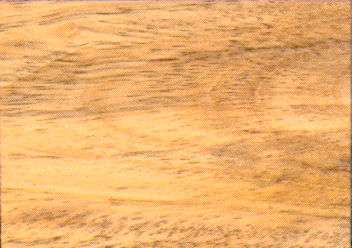
Ava (Dracontomelon mangiferum)
Family: Anacardiaceae
Common names: Ava, Basuong, Batuan, Bau, Burroa, Chinyok, Cinkuang, Dahu, Damoni, Dao, Dau, Dau payo, Dau uding, Dorea, Ehoi, Habas, Jaap, Kaih, Kaih laki, Kamarag, Kasai bukit, Kasuang, Kawilu, Lakus, Lamis, Laup, Laup mon, Layo, Lup, Lupigi, Makau, Maliyan, New Guinea walnut, Ngabauk, Ngasobar, Noyer de la Nouvelle-Guinee, Onomba, Pacific walnut, Paldao, Papua New Guinea walnut, Papuanuss, Payakoson, Prachao, Prachao-har-pra-ong, Rao, Rau, Rau takau, Sakuan, Sengkowang, Sengkuang, Senkaung, Senkuang, Serai, Singkuwang, Talansep, Tawthitcha
Distributed in: Burma, Indonesia, Malaysia, Papua New Guinea, Philippines, Thailand (Oceania and S.E. Asia)
Common uses: Boat building (general), Boxes and crates, Cabinetmaking, Carvings, Flooring, Furniture, Heavy construction, Joinery, Light construction, Matches, Moldings, Musical instruments, Paneling, Plywood, Pulp/Paper products, Toys, Turnery, Veneer, Veneer: decorative, Wheels
Tree size: Trunk diameter is 150-200 cm
Colors: the heart isYellow, Yellow to golden-yellow to orangeand the sapwoodWhite to yellow, Yellow.The grain isWavy, the textureMedium coarse to coarseand the lusterMedium
Natural durability: Susceptible to insect attack, Susceptible to marine borer attack
Silica Content: Slight
Kiln Schedules: Kiln Drying Rate (in days) is rapid
Kiln Drying Rate: Rapid (<10 days for boards < 32 mm, to <30 days for boards >= 63 mm)
Drying Defects: Moderate twist/warp, Splitting
Ease of Drying: Rapidly
Tree Identification: Bole/stem form is straight
Comments: General finishing qualities are rated as good General finishing qualities are rated as satisfactory
Blunting Effect: Blunting effect on machining is moderate
Cutting Resistance: Easy to saw
Gluing: Moderate gluing properties
Mortising: Easy to mortise
Moulding: Easy to mould
Movement in Service: Easy to mould
Nailing: Holds nails well
Resistance to Impregnation: Resistant sapwood
Response to hand tools: Easy to machine
Sanding: Good sanding finish
Veneering qualities: Veneers easily, Veneers moderately easy
Screwing: Screwing yields good results
; Turning: Good results
Polishing: Satisfactory; Staining: Finish is generally satisfactory
; Varnishing: Good;
- Numerical data Metric
- Numerical data English
- Strength properties
- References
 |
 |
 |
 |
| Item |
Green |
Dry |
Metric |
| Specific Gravity |
|
|
|
| Density |
|
592 |
kg/m3 |
| Bending Strength |
592 |
924 |
kg/cm2 |
| Crushing Strength |
275 |
449 |
kg/cm2 |
| Hardness |
|
451 |
kg |
| Impact Strength |
|
|
cm |
| Shearing Strength |
|
109 |
kg/cm2 |
| Stiffness |
99 |
114 |
1000 kg/cm2 |
| Tangential Shrinkage |
|
|
% |
| Radial Shrinkage |
3 |
|
% |
| Weight |
576 |
464 |
kg/m3 |
| Maximum Load |
|
|
cm-kg/cm3 |
| Toughness |
|
|
cm-kg |
| Static Bending |
|
|
kg/cm2 |
|
 |  |  |  | | Item | Green | Dry | English | | Bending Strength | 8422 | 13143 | psi | | Density | | 37 | lbs/ft3 | | Hardness | | 995 | lbs | | Maximum Crushing Strength | 3916 | 6397 | psi | | Shearing Strength | | 1560 | psi | | Stiffness | 1409 | 1627 | 1000 psi | | Weight | 36 | 29 | lbs/ft3 | | Radial Shrinkage | 3 | | % | | Tangential Shrinkage | 6 | | % | |
Density (dry weight) = 31-37 lbs/cu. ft.
Shearing strength (parallel to grain) = low
Max. crushing strength = medium
Shrinkage, Radial = very small
Modulus of Elasticity (stiffness) = low
Shrinkage, Tangential = moderate
Shrinkage, Radial = small
Hardness (side grain) = soft
Density (dry weight) = 46-52 lbs/cu. ft.
Density (dry weight) = 38-45 lbs/cu. ft.
Shrinkage, Tangential = very small
Shrinkage, Tangential = small
Bending strength (MOR) = low
Bending strength (MOR) = medium
Shrinkage, Tangential = fairly large
Shrinkage, Radial = moderate
Shrinkage, Radial = fairly large
Modulus of Elasticity (stiffness) = medium
Density (dry weight) = 23-30 lbs/cu. ft.
Bending strength (MOR) = high
Anon,1963,Indian Woods: Their Identification, Properties and uses. Vol.II Linaceae,to Moringaceae,Manager of Publications, Delhi, IndiaBolza, E., Kloot, N.H.,1976,The Mechanical Properties of 81 New Guinea Timbers,C.S.I.R.O. Div. Building Res. Tec.Paper (2nd series) 11Bolza, E.,1975,Properties and Uses of 175 Timber Species from Papua New Guinea and West,Irian,C.S.I.R.O. Div. Building Research Report,no.34Brown, W.H.,1978,Timbers of the World, No. 8 Australasia,TRADA, Red Booklet SeriesBudgen, B.,1981,Shrinkage and density of some Australian and South-East Asian Timbers,C.S.I.R.O. Div. building Res. Tech Paper(2nd Series) No.38D.'Eispeissis, J.L.,1940,The chief characteristics and uses of 6 New Guinea timbers,Australian Forestry 5 pp81-4Da Costa, E.W.B., Osborne, L.D.,1967,Comparative decay resistance of 26 New Guinea timber species in,accelerated laboratory tests,Comm. Forestry Review 46(1) pp63-74Desch, H.E.,1954,Manual of Malayan Timbers (2 vols,Malayan Forest Records,no.15Eddowes, P.J.,1977,Commercial Timbers of Papua New Guinea: Their Properties and Uses,Hebano Press, Port Moresby, Papua New GuineaFors, A.J.,1965,Maderas Cubanas,Inst. Nac. Ref. Agraria La HabaraKeating, W.G., Bolza, E.,1982,Characteristics properties and uses of timbers. South East Asia, Northern,Australia and the Pacific,C.S.I.R.O. Div. Chemical Technology,Inkata Press,1Kraemer, J.H.,1951,Trees of the Western Pacific Region,West Lafayette, Indiana U.S.A.Kribs, D.A.,1950,Commercial and Foreign Woods on the American Market (a manual to their,structure, identification, uses and distribution,U.S.A. Penn. State College, Tropical Woods LaboratoryKukachka, B.F.,1970,Properties of Imported Tropical Woods,Forest Research Paper FPL 125Papua New Guinea Department of Forests,1972,New Horizons,Forestry in Papua New Guinea,Jacaranda Press PTY Ltd, BrisbaneSono, P.,1974,Merchantable Timbers of Thailand.,Forest Products Research Division, Royal Forest Department, Bangkok,,Thailand.Tamolang, F.N., Martawijaya, A., Kartasujana, I., Kadir, K., Parwira, S.,1992,Indonesian Wood Atlas Volume II,Department of Forestry, Agency for Forestry Research and Development,,Bogor-Indonesia
|








